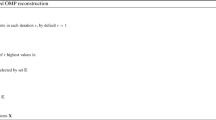Abstract
Compressed sensing (CS)-based cross-and-bouquet (CAB) model was proposed by J. Wright et al. to reduce the complexity of sparse error correcting. For the sake of leading to better performance of CS-based decoding for the CAB model, an algorithm is proposed in this paper for constructing a well-designed projection matrix to minimize the average measures of mutual coherence. One was proposed by M. Elad. Another is defined in this paper for higher dimensional cases. Using the equivalent dictionary, the dimensionality is reduced. Also high-dimensional singular value decomposition (SVD) is avoided in the procedure of constructing a well-designed projection matrix. The high-dimensional CAB model of sparse error correcting can be solved by the proposed algorithm without computational difficulty. The validity of the proposed method is illustrated by decoding experiments in high-dimensional cases.






Similar content being viewed by others
References
S. Boyd, L. Vandenberghe, Convex Optimization (Cambridge Univ. Press, Cambridge, 2004)
A.M. Bruckstein, D.L. Donoho, M. Elad, From sparse solutions of systems of equations to sparse modeling of signals and images. SIAM Rev. 51(1), 34–81 (2009)
E.J. Candès, T. Tao, Decoding by linear programming. IEEE Trans. Inf. Theory 51(12), 4203–4215 (2005)
E.J. Candès, M.B. Wakin, An introduction to compressive sampling. IEEE Signal Process. Mag. 25(2), 21–30 (2008)
E.J. Candès, J. Romberg, T. Tao, Robust uncertainty principle: exact signal reconstruction from highly incomplete frequency information. IEEE Trans. Inf. Theory 52(2), 489–509 (2006)
S.S. Chen, D.L. Donoho, M.A. Saunders, Atomic decomposition by basis pursuit. SIAM Rev. 43(1), 129–159 (2001)
D.L. Donoho, M. Elad, Optimally sparse representation in general (non-orthogonal) dictionaries via L1 minimization. Proc. Natl. Acad. Sci. 100(5), 2197–2202 (2003)
D.L. Donoho, Compressed sensing. IEEE Trans. Inf. Theory 52(4), 1289–1306 (2006)
J.M. Duarte-Carvajalino, G. Sapiro, Learning to sense sparse signals: simultaneous sensing matrix and sparsifying dictionary optimization. IEEE Trans. Image Process. 18(7), 1395–1408 (2009)
M. Elad, Optimized projections for compressed sensing. IEEE Trans. Signal Process. 55(12), 5695–5702 (2007)
M.A.T. Figueiredo, R.D. Nowak, S.J. Wright, Gradient projection for sparse reconstruction: application to compressed sensing and other inverse problems. IEEE J. Sel. Top. Signal Process. 1(4), 586–597 (2007)
J. Kennedy, R. Eberhart, Particle swarm optimization, in Proc. IEEE Int. Conf. Neural Networks, Perth, Australia (1995), pp. 1942–1948
S. Naka, T. Genji, T. Yura, Y. Fukuyama, A hybrid particle swarm optimization for distribution state estimation. IEEE Trans. Power Syst. 18(1), 60–68 (2003)
Y. Shi, R. Eberhart, A modified particle swarm optimizer, in Proc.IEEE Int. Conf. Evolutionary Computation, Anchorage, AK (1998), pp. 69–73
J. Wright, Error correction for high-dimensional data via convex optimization. Thesis (2009)
J. Wright, A.Y. Yang, A. Ganesh, S.S. Sastry, Y. Ma, Robust face recognition via sparse representation. IEEE Trans. Pattern Anal. Mach. Intell. 31(2), 210–227 (2009)
SparseLab 2.1-Core [Online]. Available: http://sparselab.stanford.edu/
Acknowledgements
This work is supported partially by Guangdong Province and National ministry of education IAR projection (Grant No. 2012B091100331) and NSFC-Guangdong union project (Grant: U0835003).
Author information
Authors and Affiliations
Corresponding author
Rights and permissions
About this article
Cite this article
Fu, Y., Zhang, Q. & Xie, S. Compressed Sensing for Sparse Error Correcting Model. Circuits Syst Signal Process 32, 2371–2383 (2013). https://doi.org/10.1007/s00034-013-9574-7
Received:
Revised:
Published:
Issue Date:
DOI: https://doi.org/10.1007/s00034-013-9574-7




